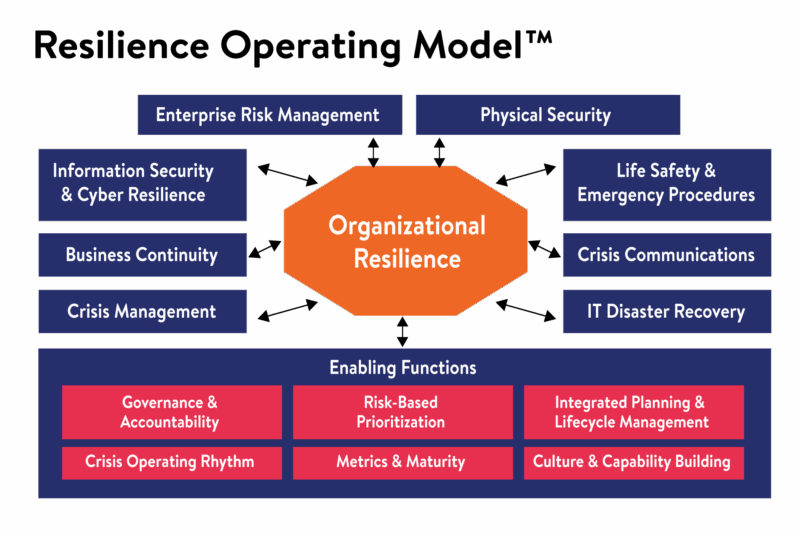Most organizations today don’t suffer from a lack of effort when it comes to resilience. They’ve invested in plans, training, and infrastructure. But when disruption hits, the response still feels slow, disjointed, or misaligned.
That’s because most organizations have resilience components — not a system.
Business continuity lives in one place. Crisis management in another. IT disaster recovery, comms, and cyber in completely different lanes. Individually, these functions may perform well — but together, they often don’t.
This isn’t just inefficient. It’s risky.
What’s missing is an integrated way to lead through disruption. What’s missing is a Resilience Operating Model™.
The Shift That’s Needed
A binder is not a response.
In a world defined by complexity and speed, resilience needs to function like a living system — not a compliance task. You can have great plans, experienced people, and a smart team… but if those parts don’t operate together, you’re not resilient. You’re fragmented.
The Resilience Operating Model™ solves that problem by creating a unified system for how resilience functions across your enterprise — before, during, and after disruption.
What is the Resilience Operating Model™️?

The Resilience Operating Model™ is a structured framework that integrates your core resilience capabilities — business continuity, crisis management, disaster recovery, information security, communications, and risk — into a single, operational system.
It defines:
- How your organization responds across domains
- Who makes decisions and how they escalate
- What gets tested, measured, and improved
- Where executive trust and strategic alignment come from
It behaves like an operating system: always running in the background, coordinating inputs, guiding decision-making, and evolving over time.
This is the shift: from disconnected activities to a connected way of operating — one that performs under pressure.
Why It Works – When Programs Don’t
Here’s the reality: most resilience “programs” aren’t built to scale, adapt, or coordinate across silos.
They’re tactical.
They’re compliance-driven.
They live in departments.
They rely on a few experienced individuals.
And they collapse under pressure.
The Resilience Operating Model™ replaces that patchwork with a system.
| Resilience Operating Model™ | Traditional Program |
|---|---|
| Unified system of execution | Collection of standalone plans |
| Shared governance across functions | Siloed ownership |
| Integrated planning and escalation | Ad hoc coordination |
| Aligned to business strategy and risk | Driven by audits or legacy requirements |
| Built for continuous improvement | Static, rarely tested |
When an organization implements the Resilience Operating Model™, response becomes faster, leadership becomes clearer, and resilience becomes credible — not just operationally, but strategically.
The Core Components of the Model
We’ll go deeper in the following article, but here’s the high-level view of what the Resilience Operating Model™ includes:
- Core Resilience Domains
The disciplines that must be aligned: business continuity, crisis, disaster recovery, information security, communications, life safety, physical security, and enterprise risk. - Enabling Functions
The systems that tie everything together: governance, cadence, escalation, metrics, exercises, culture, and capability development. - Execution Lifecycle
A repeatable method based on Bryghtpath’s Proven Process: Diagnose → Design → Deliver → Evolve
It’s not just about what you have. It’s about how it all works together — and how you improve it over time.
How to Know If You Need a Resilience Operating Model™️
Ask yourself:
- Do your BC, DR, crisis, and cyber teams plan and test together?
- Are your executives getting multiple updates from different functions in a crisis?
- Do you have a clear answer to “Who owns resilience across the enterprise?”
- Can you show measurable progress — not just activity — to leadership or the board?
If the answer to any of these is no, your organization doesn’t need another plan.
It needs a system.
→ Explore the full Resilience Operating Model™️ report
Want to work with us or learn more about Resilience?
- Our proprietary Resiliency Diagnosis process is the perfect way to advance your business continuity program. Our thorough standards-based review culminates in a full report, maturity model scoring, and a clear set of recommendations for improvement.
- Our Business Continuity and Crisis Management services help you rapidly grow and mature your program to ensure your organization is prepared for the storms that lie ahead.
- Our Ultimate Guide to Business Continuity contains everything you need to know about Business Continuity while our Ultimate Guide to Crisis Management contains the same for Crisis Management.
- Learn about our Free Resources, including articles, a resource library, white papers, reports, free introductory courses, webinars, and more.
- Set up an initial call with us to chat further about how we might be able to work together.


 Why Your Resilience Program Isn’t Working — And What to Do About It
Why Your Resilience Program Isn’t Working — And What to Do About It